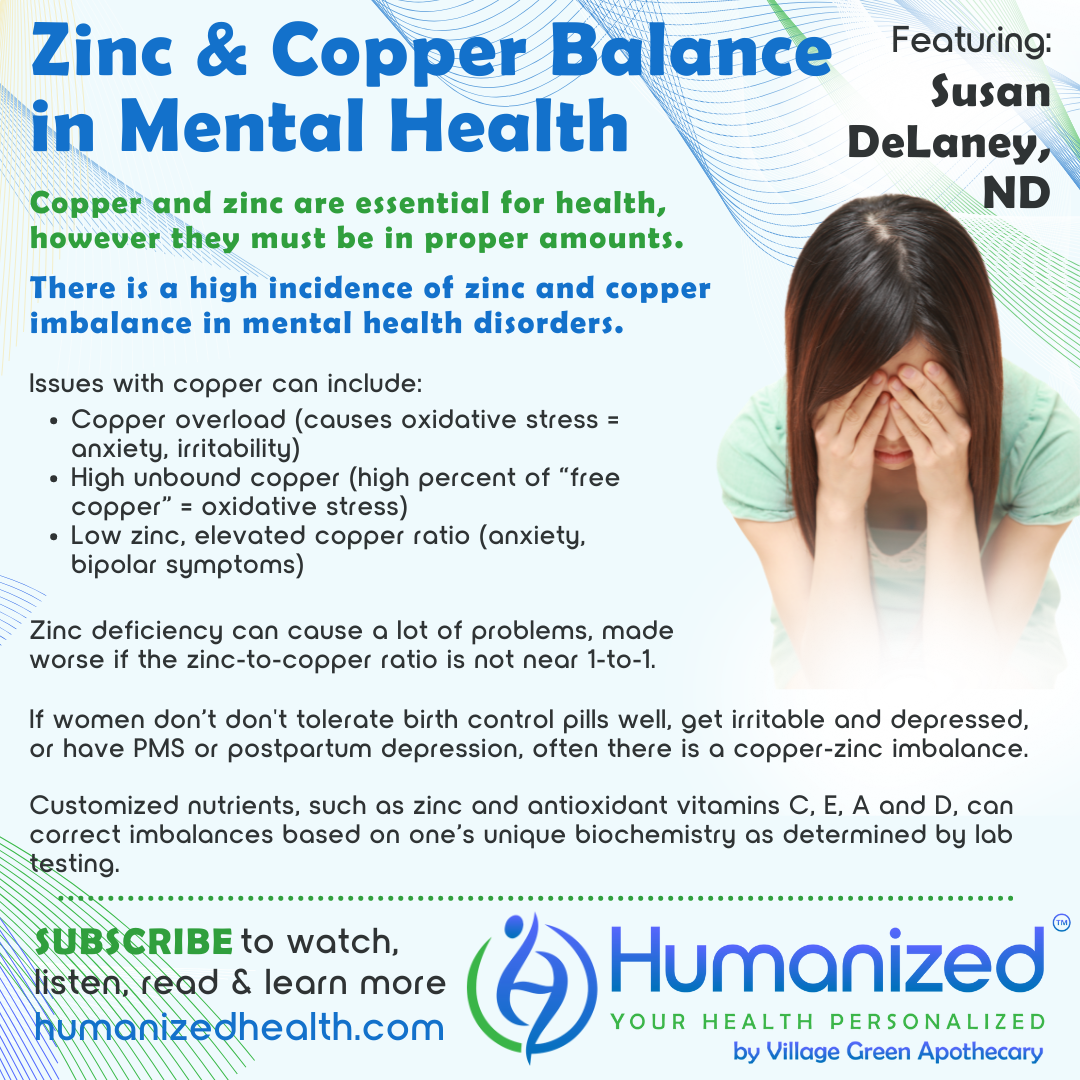Zinc and Copper Balance in Mental Health
Featuring
Susan DeLaney, ND, RN
WATCH
LISTEN
READ
Rebekah Kelley: Welcome to the Humanized podcast, all about personalizing your health. I’m your host, Rebekah Kelley. Today our topic will be Zinc and Copper Balance in Mental Health with Dr. Susan DeLaney. Before I introduce Dr. DeLaney, I want to remind everyone to subscribe and get all of our variety of casts in audio, video and transcription at HumanizedHealth.com. I’d also like to thank our lead sponsor, Village Green Apothecary, at MyVillageGreen.com.
A little bit about Dr. Susan DeLaney. She has practiced naturopathic medicine in North Carolina for over three decades. Over the years, she’s observed that the health of many people, including children, has greatly declined while the number of prescriptions has dramatically increased. By using a natural approach to healing, she’s able to help people become less dependent on prescription drugs and improve their health and vitality. In her practice, as well as in her lectures, Dr. DeLaney inspires people using up-to-date nutrition science to take personal responsibility for their own health journey. Dr. DeLaney is passionate about educating individuals and their healthcare providers about the benefits of advanced nutrient therapy for balancing biochemistry, as well as the nutritional value of eating real food and healthy fats. Dr. DeLaney’s latest project, Your Health is No Big Thing – It’s a Million Little Things, provides links to 13 educational videos to help people learn more about healthy fats, the importance of fat-soluble vitamins, as well as simple changes individuals can make to improve their health.
Thank you so much for being with us, Dr. DeLaney.
Susan DeLaney: Thanks for having me.
Rebekah Kelley: So, copper seems to be an odd nutrient to measure for mental health issues. So, share with us. Why copper?
Susan DeLaney: So, Dr. William Walsh and Dr. Carl Pfeiffer originally started testing a variety of nutrients and blood tests. They had 200 to begin with and they narrowed it down to four. And copper is one of the primary nutrients.
So with copper, there are three, actually, issues that we are concerned about. One itself is just the high free copper. So if you have a copper of 135, that copper can give you oxidative stress. And in your brain, that’s not a really good thing. It makes people anxious and irritable, and so copper alone can be a problem.
And then you can have copper unbound, and that can be a problem, as well. That’s called high percent free copper. And then you can have copper in a ratio to zinc, which we’ll talk about later, as well. And that zinc-copper ratio is also really, really important.
Rebekah Kelley: So let’s go ahead and then talk about the difference between the free copper and the bound copper, right? That’s what you were saying that we could talk [about]. What is it? What is the difference?
Susan DeLaney: Right. So like I said, your copper might be 135 and then copper is bound by a protein called ceruloplasmin. And that’s one of the four tests that Dr. Walsh looks at. So for instance, if your copper is 135, your ceruloplasmin needs to track that and be about 30 to 32. And if it’s not, then you have a percent of unbound copper left in your body, also doing oxidative stress.
Now here’s a great story to remember this by. Dr. Judith Bowman, who is the head of DHA Labs, told me this story and I’ll never forget how this works. So think of copper as the school children. Okay? And they go to school. And at the end of the day, the buses come to pick them up. But you have too many children and not enough buses. So this is free copper left alone, ravaging your brain, and it also ravages the school. So those little children spray paint the building, they turn the desk upside down, they pull out the internet. It’s a wreck by the time you get there. So when you have a high percent free copper, as well as a high copper, then that causes oxidative stress, as well. So that’s the problem with this unbound copper, as well. So we want to bring that down and that can be done with antioxidants, like vitamin C, vitamin E, A and D, also part of the protocol.
Rebekah Kelley: So you also mentioned a special relationship that copper has with zinc. Can you explain that?
Susan DeLaney: Yes. So, normally your zinc level should be between 90 and 135. So if your zinc is really low, like, say, I often see them in 70s and 80s, that’s a problem in and of itself. So a low zinc, as I mentioned before in the pyrrole one [the last segment], can reduce your ability to make GABA. And so a low zinc, you’re going to be anxious anyway. Now, if you tie that into a… even if your zinc, say, is 90 and your copper is 135, that’s a huge gap. And so it should be a one-to-one basis. So if your zinc is in the 90s, your copper should be in the 90s or 100, very close. But when you have that ratio differential, like say anything over 1.2, those people can be really anxious and have issues that look a lot like bipolar disorder, but it’s really not. It’s the improper copper-zinc imbalance.
So those are three of the tests that we do, copper, zinc and ceruloplasmin. And looking at all three of those tests, you can determine these. An educated provider can help determine you [your status] and then figure out which nutrients are best for you, based on your biochemistry.
Rebekah Kelley: So you mentioned the three lab tests. How do you obtain these lab tests to find out about your nutrient status?
Susan DeLaney: So the best thing to do is to look on the Walsh Institute.org website and go under practitioners and try and find someone trained in this protocol. Because I’ve seen some people get it from LabCorp and they’re not really sure. So we’d like to get a practitioner who’s trained in this.
And then secondly, you should do it through DHA Labs because they have an agreement with Dr. Walsh of how these tests should be drawn. So if you get a zinc in a regular tube, it can be contaminated just by the stopper or the tube itself. So LabCorp, given Dr. Walsh’s protocol from DHA, uses the exact right tubes. Then also some of these things have to be spun immediately and frozen. And so if it’s not done to his specifications, you can’t trust the lab values. Even when they’re done perfectly correctly, sometimes labs just vary 5 to 10% in any lab. That’s the problem of them.
But once we look at our labs and then we look at the personality traits that each person has, and also do the urine test, so that gives us a really good balance of how much zinc to give, and things of that nature. So he has protocols for each imbalance, but this zinc-copper imbalance is incredibly important for young women, in particular.
So if you see someone who has had problems since puberty, you’re going to go, hmm, maybe they have a copper-zinc imbalance – partly because puberty takes a lot of zinc, and you’re growing up, so your zinc level might be lower. Then, estrogen makes your copper levels go up. So you can just imagine, here comes your copper-zinc imbalance going [hand motions indicate spreading farther apart]. And these are moody children, moody teenagers. A little bit of that is expected, but I have seen young women who have been diagnosed as bipolar, they have three medications on board, and once we correct this, they’re happier than they’ve ever been in their life. So, it’s a consideration. Yes.
Rebekah Kelley: Wow. I’m thinking of someone [laughing] that we want to run this test on.
Susan DeLaney: You’re thinking of someone, you know, huh? [Laughs]
Rebekah Kelley: Yes, I am [still laughing].
Susan DeLaney: Oh, and here’s a clue. They don’t tolerate birth control pills very well.
Rebekah Kelley: Really!
Susan DeLaney: It makes them irritable and depressed. And also, people who have PMS, they have terrible PMS, right? Often zinc levels are low and copper is high. Postpartum depression, also big copper-zinc imbalance.
Rebekah Kelley: Wow. And of course there’s a lot of that, like you said, during puberty, as people are, as you know, children are changing into young adults. Right? And you do expect some of that, just trying to get a handle on one’s emotions is hard enough as it is, but then if you’re…
Susan DeLaney: And hormones. Yes.
Rebekah Kelley: Right? Yeah. [Both laugh] Wow. Thank you, Dr. DeLaney. You always give us so much to think about.
Susan DeLaney: I know it’s a lot of information, but I want people to know, “I’m not crazy, my nutrients are out of balance.”
Rebekah Kelley: “My nutrients are out of balance. My zinc and copper are not in balance.”
Susan DeLaney: Right.
Rebekah Kelley: Thank you so much, Dr. DeLaney. Dr. DeLaney can be found at www.TheWellnessAlliance.com. I’m going to spell it. It’s T H E W E L L N E S S A L L I A N C E.com. Let me remind you to subscribe and get access to all Humanized videos, podcasts and transcriptions from all of our thought leaders on personalizing your health at HumanizedHealth.com. Thanks so much for being with us. Please come back.
Susan DeLaney: Thanks for having me.









